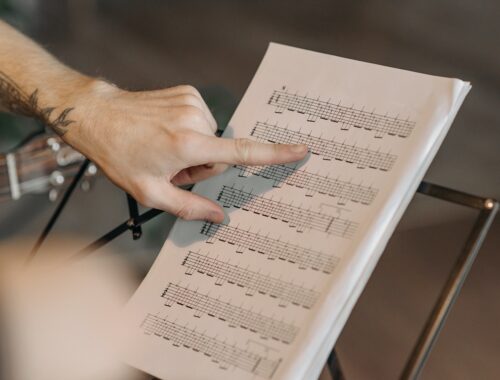
Common Guitar Strumming Patterns: A Rhythmic Foundation for Your Playing
Strumming is a fundamental element of guitar playing, and mastering common guitar strumming patterns is essential for any aspiring guitarist. Strumming patterns dictate the rhythm and groove of a song, creating the foundation upon which melodies and harmonies are built. In this comprehensive guide, we’ll delve into the world of strumming, explore some of the most frequently used strumming patterns, and provide valuable tips on how to enhance your strumming skills.
The Importance of Strumming Patterns
Before we dive into the specifics of common strumming patterns, let’s understand why they are so crucial:
- Rhythm and Groove: Strumming patterns are the backbone of a song’s rhythm and groove. They determine the pace at which you play and set the overall feel of the music, whether it’s a toe-tapping country ballad or a foot-stomping rock anthem.
- Dynamic Expression: Different strumming patterns allow you to express different emotions and dynamics within a song. A slow and gentle strum may convey a sense of melancholy, while a rapid, aggressive strum can infuse energy and intensity.
- Complementing Melodies: Strumming patterns work in harmony with chord progressions and melodies. The right strumming pattern can enhance the mood of a song, making it joyful, reflective, or dramatic, depending on the desired effect.
- Versatility: Mastering various strumming patterns opens up a world of possibilities. You can adapt your strumming style to suit different musical genres and songs.
Understanding Strumming Notation
Strumming patterns are often notated using a combination of symbols and abbreviations. Here are some common symbols and their meanings:
- Downstroke (↓): A downstroke indicates that you should strum the strings from the thickest (low E) to the thinnest (high E) string.
- Upstroke (↑): An upstroke indicates strumming in the opposite direction, from the high E string to the low E string.
- X: This symbol suggests muting or not playing the strings. You might use the palm of your hand to mute the strings for a percussive effect.
- D: A “D” signifies a downstroke, while “U” represents an upstroke. These letters may appear in sequence to indicate a strumming pattern.
- / (forward slash): A forward slash symbolizes a quick, light strum across the strings. It’s often used in patterns to create a syncopated or percussive feel.
- Chord Changes: Sometimes, strumming patterns include chord change indications (e.g., G to C). This informs you to change chords at that specific point in the pattern.
Common Strumming Patterns
Here are some of the most frequently used and versatile strumming patterns that every guitarist should have in their repertoire:
- Basic Downstrokes: This is the simplest strumming pattern, consisting of consecutive downstrokes. It’s great for straightforward, slow-tempo songs.Copy code
↓ ↓ ↓ ↓ - Down-Up Strumming: This pattern alternates between downstrokes and upstrokes, creating a balanced, steady rhythm.Copy code
↓ ↑ ↓ ↑ - Four-Beat Strum: This common pattern adds a little more groove to your playing, emphasizing the first and third beats.Copy code
↓ ↑ ↓ ↑ - Sixteenth-Note Strumming: Sixteenth notes involve quick, continuous strumming and are often used in fast-paced songs or to create a sense of urgency.Copy code
↓ ↑ ↓ ↑ ↓ ↑ ↓ ↑ - Three-Beat Waltz: This pattern is perfect for waltz time signatures (3/4) and gives your strumming a lilting, dance-like quality.Copy code
↓ ↑ ↓ ↑ ↓ ↑ - Island Strum: Also known as the “Calypso strum,” this pattern is commonly used in reggae and tropical music. It features a percussive upstroke followed by a triplet downstroke.Copy code
↓ ↑ ↓ ↓ ↑ - D-DU-UD Strumming: This versatile pattern combines downstrokes, upstrokes, and quick strums for a dynamic and engaging rhythm.Copy code
↓ ↓ ↑ ↓ ↑ ↓ - Rock Power Chords: Common in rock music, this pattern involves heavy downstrokes, often muting the strings between the strums for a powerful sound.Copy code
↓ X ↓ X
Tips for Mastering Strumming Patterns
- Start Slow: Begin with a metronome at a slow tempo. It’s crucial to get the pattern right at a slow pace before increasing speed.
- Practice with Chord Changes: Incorporate chord changes into your strumming practice. This will help you smoothly transition between chords while maintaining the strumming pattern.
- Focus on Dynamics: Pay attention to the dynamics of your strumming. Lighten your touch for softer sections and emphasize the strumming for louder parts of a song.
- Experiment with Accents: Experiment with adding accents to specific strums within a pattern. For example, accent the first downstroke for added emphasis.
- Use a Drum Machine or Metronome: These tools can help you stay on beat and develop a solid sense of timing.
- Jam with Songs: Play along with songs to practice strumming patterns in a musical context. This helps you understand how patterns fit into songs.
- Record Yourself: Recording your practice sessions can be a valuable tool for evaluating your progress and identifying areas for improvement.
Mastering common guitar strumming patterns is a fundamental step in becoming a well-rounded guitarist. These patterns lay the rhythmic foundation for your music and enable you to express a wide range of emotions and styles. As with any skill in music, consistent practice is essential. Start slow, focus on your technique, and gradually increase the complexity and speed of the patterns you tackle. With dedication and perseverance, you’ll find that strumming becomes second nature, and you’ll be able to create captivating rhythms that elevate your guitar playing to new heights.
You May Also Like

Barre Chords: Tips for Mastery
July 21, 2023
Play With Other Musicians
April 23, 2023

